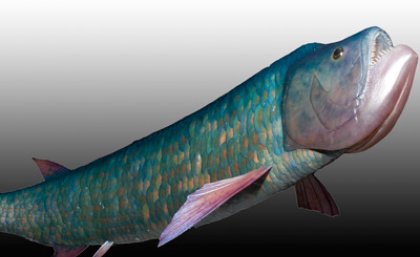
The Isisford bulldog fish, which surfaced from a 100 million year slumber eight years ago, will make its public debut at the Outer Barcoo Interpretation Centre in Isisford tomorrow (Saturday 20 April).
The Central Western Queensland fossilised fish was unearthed in a 2005 dig led by The University of Queensland’s Dr Steve Salisbury.
The fossil of the large, fast-swimming predatory fish is estimated to be between 103 and 100 million years old, and belongs to a group of fishes known as ichthyodectiforms.
Ichthyodectiforms are an extinct group of fishes that were a common element of shallow marine fish faunas during the latter part of the Age of Dinosaurs.
Their large, upward opening jaws and jagged teeth have led them to be commonly referred to as ‘bulldog fish’.
UQ’s School of Biological Sciences researcher, Mr Kerry Geddes, said the fossil was entombed in a single nodule of sandstone, close to where the skull of Isisfordia duncani, the world’s first modern crocodilian, was found.
“I decided to hit the nodule with my hammer and was surprised to find the preserved near-perfect skull and front half of the body,” Mr Geddes said.
“We estimate the fish to have been just under a metre long.”
UQ’s School of Biological Sciences graduate Rodney Berrell prepared and studied the fossil.
“Preparation of the fossil took about six months using a combination of drilling and diluted acetic acid to gradually expose the delicate bones,” he said.
Based on comparisons with other fossilised and living fishes, Mr Berrell and experts from Mexico and Japan, surmise this specimen belongs to a type of ichthyodectiform known as Cladocyclus.
“The Isisford fossil represents the first record of Cladocyclus in Australia, and indicates that species of this fish also inhabited freshwater environments,” Mr Berrell said.
Zoologist and paleontologist Dr Steven Salisbury also studied the bones.
“It is likely that the Isisford bulldog fish travelled up river to Isisford from the contracting Eromanga Sea, which was probably still open to the north through the Gulf of Carpentaria when the Isisford fossils were deposited,” he said.
“Together with the crocodilians found previously, these fishes are helping us piece together aspects of the unique fauna that inhabited this part of Queensland during the later part of the Age of Dinosaurs,” Dr Salisbury said.
The Outer Barcoo Interpretation Centre is open daily from 9am-5pm. (07) 4658 8411
Media: Dr Steve Salisbury +61 407 788 660, s.salisbury@uq.edu.au. Tracey Franchi, UQ School of Biological Sciences Communications Manager, +61 7 3365 4831, t.franchi@uq.edu.au.
For more information on the Isisford fauna: www.uq.edu.au/dinosaurs
About the School of Biological Sciences
Through research undertaken in the School, UQ has been ranked by the 2012 National Taiwan University Rankings in the top five universities globally for research in ecology and environmental biology and in the top 18 universities globally for plant and animal biology. The UQ School of Biological Sciences attracts researchers of world standing in a range of disciplines, with international leaders in many diverse fields. Our work spans the scales of biological organisation, from molecules and cells to organisms, populations, species and communities. With more than 150 researchers working in evolution, global change biology, ecology, aquaculture, animal behaviour, physiology, entomology, zoology, botany, genomics, development and conservation biology, our researchers and graduate scientists are well-equipped to make a real difference in contributing to solving global problems.











